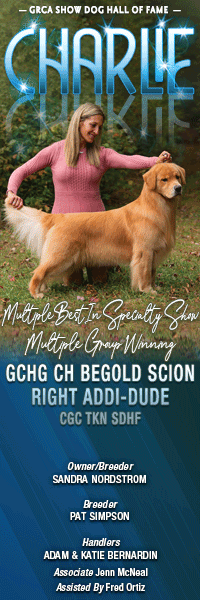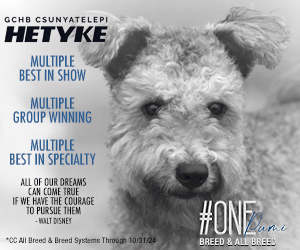Little Daddy – Putting Min Pins On The Map
From the archives of The Canine Chronicle, September, 2012
At early dog shows, the exhibition of Toy breeds was considered an insignificant factor in the competition. That misperception was quickly revised as big winners began to emerge from this group. However, less glamorous members of the Toy Group continued to be overlooked. That usually didn’t change until one particular dog arrived on the scene to shake up the status quo and break that frustrating pattern. The flashy red Min Pin Ch. Rebel Roc’s Casanova V Kurt didn’t need imposing size or glamorous coat to make his mark in group and BIS competition. His record of 146 groups and 75 BIS remained unchallenged for decades.
In 1962 he was named Quaker Oats Top Toy, Popular Dogs Top Dog, and his breeder, E. W.Tipton, was awarded top owner/handler. Like most men, “Tip” didn’t consider himself a Toy dog person until Mrs. Tipton’s Min Pin fascination settled that issue.
Recognized in Germany in 1895 as the Zwergpinscher, the Miniature Pinscher was equally well-known as the “Reh” Pinscher, a name was derived from its resemblance to small, red Reh deer common in Germany. That somewhat ironic moniker belied the size and coarseness of many early specimens.
First imported to America in 1919, Min Pins were exhibited Miscellaneous until 1925 when AKC recognized the breed as a Pinscher (Toy) and shuffled it to the Terrier Group. It was reclassified as a Toy in 1930, but the resulting identity crisis slowed breed evolution until 1929 when the formation of the Miniature Pinscher Club of America jumpstarted interest in the breed. Prominent kennels emerged all over the country and Min Pins boasted one of the highest percentages of show entries for registered breeds. However, typical specimens of the era were short legged and heavy boned with round apple heads.
In 1956, the Tiptons purchased their foundation bitch from Maise Booher’s Bel Roc kennel in West Virginia. This bloodline contributed many of the dogs that ultimately transformed the Min Pin into the elegant, stylish breed we know today. Her top producing stud, Ch. Bel Roc’s Dobe v Entzel, was especially influential. The Tipton’s bitch, Ch. Bel Rock’s Sugar v Entzel, became one of his many BIS winning offspring.
Sugar’s record of ten groups, one BIS, and a national specialty was respectable. But it didn’t hint at what was to come when her daughter whelped three male pups on 9/11/58. They came to be known as Big, Middle, and Little Daddy thanks to the film adaptation of Tennessee Williams classic Cat on a Hot Tin Roof, which then dominated the box office.
 Early on, Little Daddy was the standout. Sturdy and compact, with a deep brisket, short loin and a long graceful neck, he also possessed the elusive head traits that breeders desperately sought – beautiful dark eyes, perfect high-set ears, and a flat narrow, tapered skull.
Early on, Little Daddy was the standout. Sturdy and compact, with a deep brisket, short loin and a long graceful neck, he also possessed the elusive head traits that breeders desperately sought – beautiful dark eyes, perfect high-set ears, and a flat narrow, tapered skull.
Little Daddy also had attitude. True to his Pinscher heritage, he was tough and spunky.
He was handled throughout his career by Tip who described him as joy and a challenge. Notoriously difficult to lead train, Tip worked with him daily. Their resulting rapport became the basis of an unstoppable team. At eight months of age, Little Daddy’s career was launched like a rocket when Alva Rosenberg awarded him his first BIS. Four months later he had ten groups and five BIS. He was Group Second at Westminster in 1960 and 1961, Group Third in 1962, and Group First in 1963.
Shown 162 times during his four-year campaign, he earned 140 consecutive BOB wins and never failed to place in group. In 1962 and 63 he WON every group he competed in. He won BIS in 28 different states and only flew twice during his career. More importantly, his confidence, style, and ring presence raised the bar for Min Pin presentation.
His 47 champion get became the basis for some of the breed’s most successful bloodlines including Bo-Mar established by Dr. and Mrs. Buris Boshell in 1956. Bo-Mar winners included Ch. Bo-Mar’s Road Runner, the sire of 73 champions, and the first top winning black and red, and the 1965 national specialty winner, Ch. Bo-Mar’s Drummer Boy.
John McNamara also used Rebel Roc stock to found his Jay Mac bloodline in 1962. It produced over 110 champions including the bitch that was considered the epitome of modern Min Pin type in her day, Ch. Jay Mac’s Impossible Dream. Handled by Joe Waterman, she was 1975’s top Toy and her career total included 45 BIS and 175 group wins.
None of this would have been possible had Little Daddy not come along to blaze the trail for Min Pins in the USA.

Short URL: https://caninechronicle.com/?p=33833
Comments are closed












